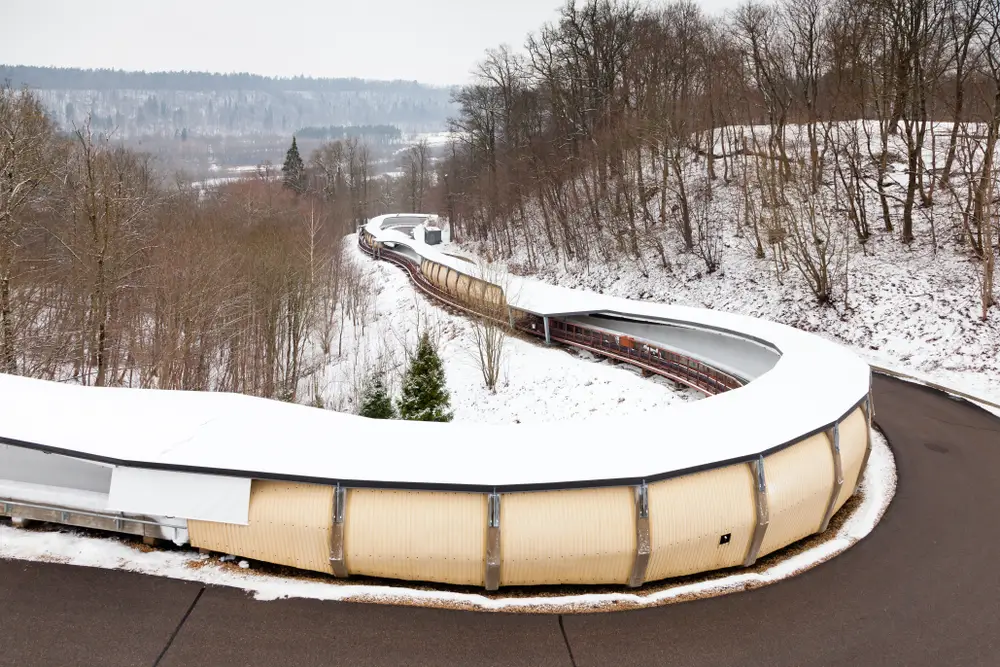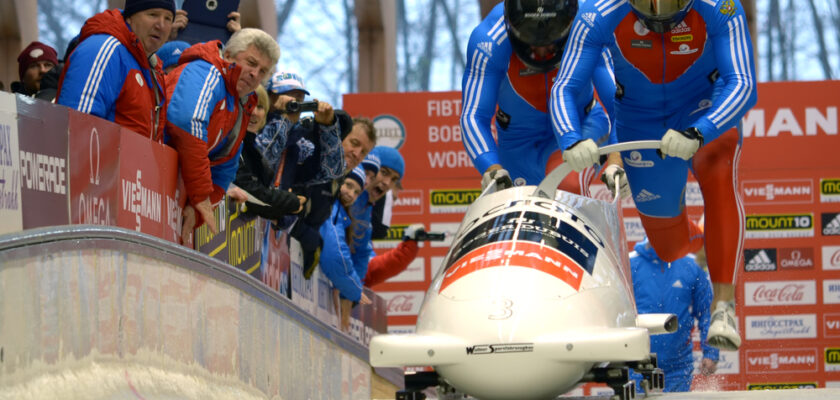Skeleton is a winter sport that is not very well known, but is very popular in specific regions. The sport, which is full of speed and adrenaline, takes place on sleds that slide down a winding ice track.
As it’s a very complex sport, it’s essential to learn the main rules of skeleton, from the size of the track, the number of competitors in the races, the equipment used and much more! The more you learn, the more fascinating the sport will be.
So check out the main rules of skeleton!
Open your Betano account and get up to 1,000 reais in bonuses.
PIX payments, live games and super odds!
Click here to open your account!

Skeleton rules: complete list
- Game location;
- Equipment;
- Duration;
- Scoring;
- Competitors;
- Infractions and penalties;
- Safety;
- Training;
- Refereeing and supervision.
Skeleton rules: playing venue
The skeleton track is built in mountainous areas covered in ice. It ranges in length from 1,200 to 1,500 meters, with a gradient of up to 15 degrees in some sections.
The width of the track must be sufficient to allow the sleds to pass safely, and it usually varies between 1.5 and 2 meters.
The curves are one of the most critical elements of the track, as they have various slopes and angles that challenge the athletes’ ability to maintain control at high speeds.
The construction of the track must follow strict engineering standards, ensuring that all sections are evenly frozen and that the ice surface is in ideal condition for competition.
Skeleton rules: equipment
Among the skeleton equipment is the sled, which is made of lightweight materials such as carbon fiber and stainless steel. It should have the following dimensions: length between 80 and 120 cm and width between 38 and 50 cm.
The weight of the sled, including any additional safety equipment, must not exceed 43 kg for men and 35 kg for women.
The athletes’ clothing includes a helmet with a visor, tight-fitting clothing made of resistant and slippery material, gloves and special shoes with nails in the soles to help with the initial boost phase.
All equipment used in the sport must be inspected before competitions to ensure it meets safety standards.
Skeleton rules: duration
Skeleton competitions are usually divided into several descents, with each athlete having the opportunity to go down the track several times.
The total duration of the competition can vary depending on the number of participants and the format of the event. In elite competitions, for example, each athlete makes two to four descents, with the accumulated time determining the winner.
Each descent lasts on average between 50 seconds and a minute, depending on the length and complexity of the track. The total competition time, including the breaks between runs and the time needed to prepare the track, can take several hours.
Skeleton rules: scoring
Scoring in skeleton is based on the total time of the athletes’ descents. Each descent is precisely timed using advanced electronic systems that guarantee accuracy down to the thousandth of a second.
The athlete with the lowest cumulative time at the end of all the descents is declared the winner of the race.
In the event of a tie, the decision is made based on the times of the individual descents, starting with the last descent. If the tie persists, the analysis continues with the previous descents until the tie-breaker takes place.
Skeleton rules: competitors
Skeleton competitions can vary in terms of the number of participants, depending on the level and format of the event. In high-level international competitions, such as the Olympic Games, the number of participants is limited, with a maximum of 30 to 40 athletes in each category (male and female).
In national and regional competitions, the number of participants can be higher, depending on the organization and infrastructure available. The order of descent is usually determined by drawing lots or by the athletes’ ranking.
Skeleton rules: infractions and penalties
There are several infractions in skeleton that can result in penalties for athletes. Among the most common infractions are:
- False starts: if an athlete starts the descent before the official signal, they may be penalized with additional time.
- Irregular equipment: any equipment that does not comply with the rules may result in the athlete being disqualified.
- Unsportsmanlike conduct: behavior that compromises the safety or integrity of the competition can lead to disqualification.
Penalties range from adding time to the athlete’s total time to disqualification from the competition, depending on the severity of the infraction.
Skeleton rules: safety
Athlete safety is a priority in skeleton competitions. Therefore, the track must be inspected regularly to ensure that there are no imperfections or hazards that could put athletes at risk.
The sides of the rink are equipped with safety barriers designed to prevent athletes from leaving the rink at high speed. In addition, the maintenance of the ice surface is extremely crucial.
This is why maintenance teams are constantly working to ensure that the ice is in top condition, using specialized equipment to smooth and repair the surface.
Skeleton rules: training
Before competitions, athletes have the opportunity to train and familiarize themselves with the track. These practice sessions are regulated and can be done without any hindrance.
However, each athlete has a limited number of practice runs, and the track conditions must be kept similar to those of the official competition.
Practice time is monitored and limited to avoid any athlete gaining an unfair advantage. Practices are usually spread over several days before the main competition.
Skeleton rules: refereeing and inspection
Skeleton competitions are overseen by a team of trained referees and officials. They are responsible for ensuring that all the rules are followed and for reviewing any infractions that may occur.
Timing is an important part of the enforcement process, with advanced electronic systems ensuring accuracy and minimizing the risk of human error.
Any disputes over times or infractions are resolved by the refereeing team, which has the final say on all regulation issues.

Skeleton rules: complete list
- Game location;
- Equipment;
- Duration;
- Scoring;
- Competitors;
- Infractions and penalties;
- Safety;
- Training;
- Refereeing and inspection.
These are the rules of skeleton! If you enjoyed learning more about the sport, take the opportunity to check out more about it by browsing the site. Don’t forget to leave a comment!



